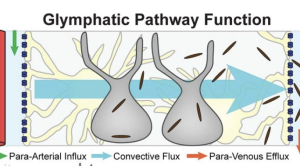In a retrospective cohort study, Qingwen Chen et al. (Qingyuan People’s Hospital; Guangdong Pharmaceutical University; South China Normal University, Guangzhou) published in CNS Neuroscience & Therapeutics, investigated the presence and temporal dynamics of glymphatic dysfunction in chronic-phase stroke using the diffusion tensor imaging along the perivascular space (DTI-ALPS) index. The study further aimed to correlate this dysfunction with domain-specific cognitive outcomes stratified by lesion topography.
The authors observed that glymphatic impairment — as measured by reduced ALPS indices — persisted up to one year after stroke, with asymmetry favoring more impairment in the lesioned hemisphere at 3 months, followed by partial recovery at 12 months. However, cognitive correlations (primarily in motor and memory domains) were weak, inconsistently significant, and vanished by one year. Neither lesion volume nor cortical vs subcortical location predicted ALPS values.
Critical Review
This study introduces a compelling premise — glymphatic dysfunction as a chronic, measurable consequence of ischemic stroke — but its translational value remains limited. The authors apply the DTI-ALPS metric longitudinally, which is methodologically novel, yet still lacks validation against gold-standard glymphatic tracers. As a surrogate marker, ALPS remains indirect, anatomically constrained, and highly sensitive to white matter tract orientation and noise.
The retrospective design (n = 51) inherently limits inferential power and increases susceptibility to selection and confounding bias. The lack of robust statistical correction for multiple comparisons, particularly in exploratory cognitive correlations, raises the specter of false positives. Moreover, the null findings regarding lesion size and location further obscure any mechanistic pathway between structural injury, glymphatic flow, and cognition.
The study also omits predictive modeling or interventional context — thus offering little actionable guidance for clinicians. While its findings suggest that glymphatic impairment may persist in some stroke patients, the observed changes in ALPS are modest and inconsistently linked to clinical endpoints. This weakens the rationale for incorporating ALPS metrics into post-stroke cognitive recovery paradigms.
Final Verdict: Innovative but inconclusive.
Takeaway for the Neurosurgeon: Chronic glymphatic dysfunction may linger post-stroke, but current imaging methods lack specificity, validation, and clinical utility for decision-making.
Bottom Line: DTI-ALPS captures subtle post-stroke changes but does not yet support targeted interventions or cognitive prognostication.
Rating: 5/10
Chen Q, Zhong T, Liu J, Yuan B, Gao H. Chronic Glymphatic Dysfunction Modulates Domain-Specific Cognitive Recovery After Stroke: A DTI-ALPS Lesion Stratification Study. CNS Neurosci Ther. 2025 Jul;31(7):e70512. doi: 10.1111/cns.70512. PMID: 40654130.
